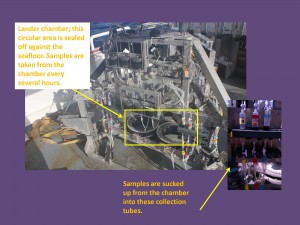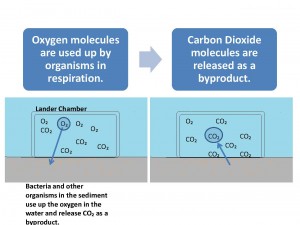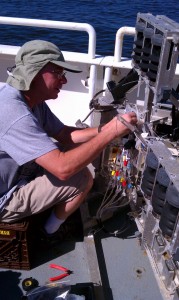To Breathe or Not to Breathe
First thing this morning was retrieving the Lander. It had been left at its most recent station for over 2 days where it had been collecting water samples at pre-set times. The whole science team was quiet as they waited patiently for the Lander to surface, hoping that something didn’t go wrong and keep the instrument at the bottom of 2000 meters of ocean. To everyone’s relief it surfaced about 45 minutes after we began the search. The reason Dr. Berelson deploys the Lander is to measure the rate of oxygen  consumption on the sea floor. It works by creating a semi-closed system and measuring the rates of change of different chemicals in the water. It works on the same principle as an ecosphere, with one exception. An ecosphere is a glass sphere that has little shrimp and algae inside; they are completely sealed and require no feeding, cleaning, or other maintenance except to keep them in moderate sunlight throughout the day. They are able to remain sealed because inside is a balance of the processes of photosynthesis and respiration. Photosynthesis is a process in which organisms such as plants and algae take the sun’s energy, carbon dioxide, and water and convert them into stored energy (sugar) and oxygen. Respiration is just the opposite process; sugar and oxygen are converted into carbon dioxide and water.
consumption on the sea floor. It works by creating a semi-closed system and measuring the rates of change of different chemicals in the water. It works on the same principle as an ecosphere, with one exception. An ecosphere is a glass sphere that has little shrimp and algae inside; they are completely sealed and require no feeding, cleaning, or other maintenance except to keep them in moderate sunlight throughout the day. They are able to remain sealed because inside is a balance of the processes of photosynthesis and respiration. Photosynthesis is a process in which organisms such as plants and algae take the sun’s energy, carbon dioxide, and water and convert them into stored energy (sugar) and oxygen. Respiration is just the opposite process; sugar and oxygen are converted into carbon dioxide and water.
The equations for each are as follows:
Photosynthesis: CO₂ + H₂O + sunlight (energy) –> C₆H₁₂O₆ + O₂
Carbon + Water + Energy yields Sugar + Oxygen
dioxide
Respiration: C₆H₁₂O₆ + O₂ –> CO₂ + H₂O + energy
Sugar + Oxygen Carbon + Water + Energy
dioxide
*Please Note- Equations are not balanced.
Notice that these processes are opposite of each other. Remember that all life on Earth operates on the need of energy. Every living thing has to either get that energy directly from the sun, or consume another organism for the energy that the organism holds in its body. Plants use the suns energy directly, and have figured out a way to store that extra energy in the form of sugar. Sugar is to a plant what fat is to us. Storing energy is kind of like putting money in a bank. Plants are making lots of extra money (energy); more than they can spend, so they take that additional money and put it away for later use (in the form of sugar). Organisms that eat plants have figured out that they don’t have to make money (energy) of their own; they can spend the plants energy (money) by consuming the plant and transferring the plants saved money into their own account. In our case the energy undergoes a currency change, going from sugar to fat.
Most organisms on Earth require oxygen in order to survive. This oxygen, that organisms including ourselves need, has not always been present in Earth’s atmosphere. Not until photosynthesizers started photosynthesizing did Earth’s atmosphere start to fill with oxygen. Now we (and other living things) can use that oxygen to fuel the chemistry in our bodies. We use the byproduct (oxygen) of other organisms and produce carbon dioxide as our own byproduct. Photosynthesizers take that carbon dioxide into their system and give back oxygen. It’s a cycle that goes round and round.
Both photosynthesis and respiration happen in the ecosphere (and on earth) in a balance. As oxygen is consumed in respiration, photosynthesizers are producing it. So what would happen in the ecosphere if you removed the photosynthesizers and respiration continued? Oxygen would continue to get used up until there wasn’t any left; then the organisms that rely on oxygen would die. Dr. Berelson essentially makes a system similar to one of these ecospheres on the seafloor and measures the rate of oxygen use over the course of 24 hours. He wants to know how quickly the oxygen that is in there is getting used up. His Lander encloses an area against the seafloor and lets nature take its course. His tubes collect samples of the water at 6 different time intervals so that when the Lander returns he can measure the oxygen as it was at a particular time and develop a graph that shows him how oxygen levels changed. His results show that oxygen is being used up in the Lander, but no new oxygen is supplied, so we now can measure the rate that oxygen is being used. Usually oxic waters (water with oxygen) are resupplied to the bottom of the sea. The Lander has stopped the resupply of oxygen to the system. Now we can determine how quickly oxygen is being consumed in that system.
 The graph above does not represent actual data, however it is exemplary of the processes that do occur. Each of those dots represents a sample of water that was collected at the time indicated. The first set of dots represents water that was taken right after the Lander was left on the floor. You can see that the oxygen concentration at that time was about 90 µmol. After 16 hours the amount of oxygen in the chamber was right about 40 µmol, so it dropped by 50 units. The oxygen in the chamber was getting used up; the organisms (mainly bacteria) that live in the sediment were using the oxygen in the water; now Dr. Berelson knows that the rate of oxygen consumption on that part of the seafloor is about 50 µmol of Oxygen/16 hours. Now he can multiply that number by the total area of the Gulf’s seafloor and determine the rate of oxygen use for the entire Gulf! Aside from measuring oxygen,
The graph above does not represent actual data, however it is exemplary of the processes that do occur. Each of those dots represents a sample of water that was collected at the time indicated. The first set of dots represents water that was taken right after the Lander was left on the floor. You can see that the oxygen concentration at that time was about 90 µmol. After 16 hours the amount of oxygen in the chamber was right about 40 µmol, so it dropped by 50 units. The oxygen in the chamber was getting used up; the organisms (mainly bacteria) that live in the sediment were using the oxygen in the water; now Dr. Berelson knows that the rate of oxygen consumption on that part of the seafloor is about 50 µmol of Oxygen/16 hours. Now he can multiply that number by the total area of the Gulf’s seafloor and determine the rate of oxygen use for the entire Gulf! Aside from measuring oxygen,  Dr. Berelson also measures CO₂ levels. If you look back at the equation for respiration you’ll see that not only is oxygen getting consumed, but carbon dioxide (CO₂) is getting produced; so as oxygen levels go down, CO₂levels go up.
Dr. Berelson also measures CO₂ levels. If you look back at the equation for respiration you’ll see that not only is oxygen getting consumed, but carbon dioxide (CO₂) is getting produced; so as oxygen levels go down, CO₂levels go up.
It goes back to the simple cycle of photosynthesis and respiration. Both processes exist in a balance that enables organisms in an ecosystem to take advantage of different chemicals and not waste anything in their environment.
 After collecting the Lander, retrieving his samples, and analyzing them, Dr. Berelson started setting up another Lander to be deployed at another location tomorrow. Each time he drops one of his Landers into the water is another chance for him to get some valuable samples and data.
After collecting the Lander, retrieving his samples, and analyzing them, Dr. Berelson started setting up another Lander to be deployed at another location tomorrow. Each time he drops one of his Landers into the water is another chance for him to get some valuable samples and data.
There is an experiment that be done in the classroom to demonstrate this idea of oxygen use and consumption much like what happens in Dr. Berelsons Lander Chamber. If you were to take a marine animal, let’s say a fish, and measure the amount of oxygen in its water before and after a time period (let’s say an hour), you could determine the rate of oxygen consumption of that fish. If you visit the teachers’ resource link on the main page it’s called Respiration and Photosynthesis in Marine Ecosystems. Students will create a closed system and measure the rate of oxygen use/production of various organisms, not only fish. In the same lab they will also investigate if temperature and respiration are related to each other. Respiration and Photosynthesis Lab
Check out It’s a Plankton Life, a poem in honor of the tiny creatures that inhabit our oceans and make our lives possible.
Have a great night!
Wessal


 August 11, 2011
August 11, 2011 






Recent Comments